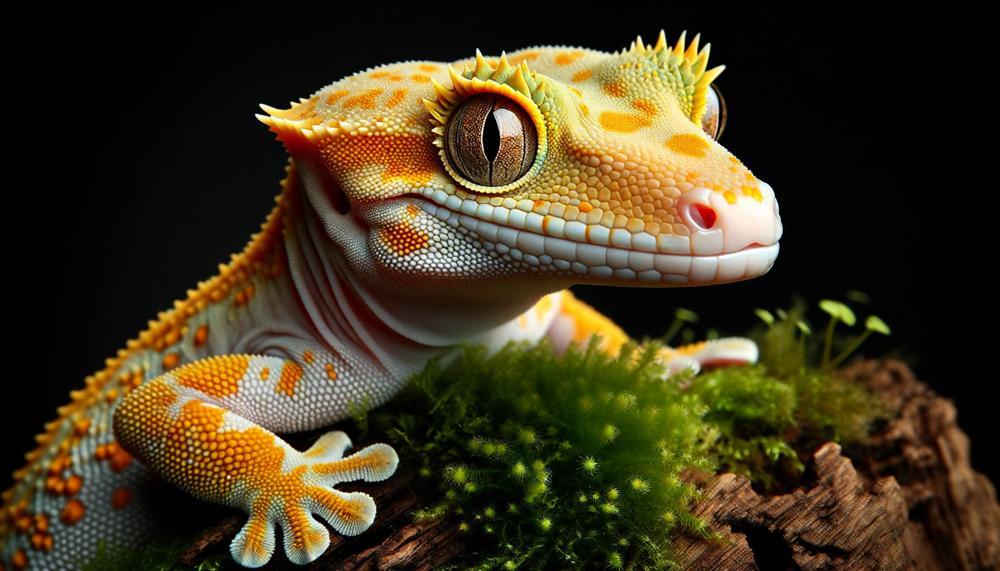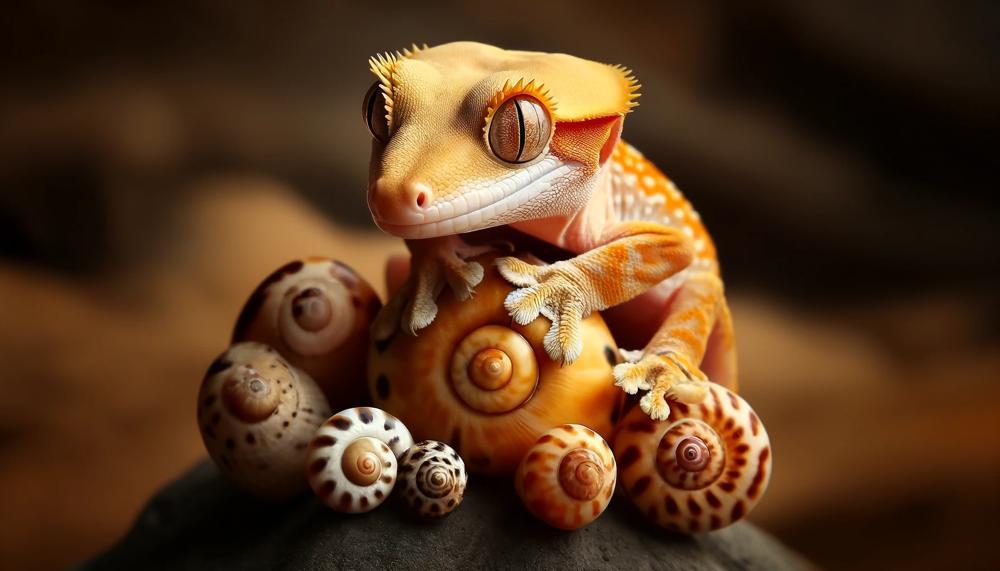Imagine finding a creature that is small enough to fit on the tip of your finger but looks as big as the dinosaurs did. The crested gecko is one of the most interesting and easy-to-care-for lizard pets today. This is not a scene from a fiction book; it’s a real-life experience. The most amazing thing about these animals is not just their bright personalities and unique looks, but also how big they are. Craped geckos can get as long as a normal pencil, but from their point of view, the world is as big and complicated as any jungle.
We’ll look at the surprisingly wide range of crested gecko sizes in this piece, from hatchlings that are about the size of a paper clip to adults that are so big and heavy they might surprise you. We’ll talk about the genetics and environmental factors that affect their growth, as well as how their size affects their care, the space they need, and even how they interact with people and other geckos.
So, how big do crested geckos get?
Crested Geckos are small to medium-sized lizards. Here’s a general growth chart for Crested Geckos:
- Hatchling: 1.5 – 2 grams in weight and 2.5 – 3 inches in length.
- Baby (2 months): 3 grams in weight and 3 – 4 inches in length.
- Juvenile (3 to 6 months): 4 to 9 grams in weight and 3 – 7 inches in length.
- Juvenile (9 months): 16 – 35 grams in weight and 6 – 9 inches in length.
- Juvenile transitioning to adult (12 months): 35 – 50 grams in weight and 9 – 16 inches in length.
- Adult (18-24+ months): 35 – 55+ grams in weight and 9 – 16+ inches in length.
It takes between 12-24 months for a Crested Gecko to become fully grown, although sometimes this can take up to 3 years. They are considered to be sexually mature adults at 35 grams, which usually happens around 12-18 months.
Factors such as diet, temperature, and humidity all have a direct impact on how quickly your Crested Gecko reaches its full size. They are all unique individuals, meaning they will develop at different rates and reach different full adult sizes.
Contents
Facts About Crested Geckos
Crested geckos, once believed vanished, made a spectacular comeback in 1994 when they were rediscovered in New Caledonia. They have since climbed the ranks in the pet trade, courtesy of large breeding operations across the United States and Europe. Their easy-going nature paired with a kaleidoscope of colors makes them a favorite among enthusiasts.
When pondering the growth of these critters, it’s fascinating to note that they zip to their full stature in a mere 12 to 24 months, occasionally stretching it out to 3 years. Their growth isn’t a marathon but more of a sprint to the finish line, after which they hit a plateau. Weighing in at 35 grams signifies their readiness for adulthood, a milestone they typically reach between their first and second year. This isn’t just a figure on a scale; it marks their entry into maturity, ready to contribute to the next generation.
The commitment to a crested gecko is not fleeting; these companions are in it for the long haul, with lifespans stretching up to 20 years in captivity. This longevity beckons a dedicated caretaker, ready to provide a forever home with ample space and love. Ensuring their well-being involves a tapestry of care, from the ambiance of their habitat to the gourmet diet that fuels their growth.
| Aspect | Detail | Notes |
| Average Size | 8 inches (20 cm) from snout to tail | This includes the tail, which can be dropped and regrown in some cases. |
| Growth Continuation | No, they do not grow throughout their lifespan | Most reach their full size within 12-24 months, sometimes up to 3 years, and then growth ceases. |
| Sexual Maturity | 35 grams, around 12-18 months | Sexual maturity is often a better indicator of maturity than size alone. |
| Lifespan in Captivity | 10-20 years | Owning a crested gecko requires a long-term commitment to their care. |
Crested Gecko Size and Growth Chart
Crested Geckos, with their captivating colours and amiable dispositions, average an adult size range of 18 to 20 centimetres (7 to 8 inches) from snout to tail tip.
When you consider the patchwork of gecko species around the globe, this places them on the more robust end of the spectrum. Now, let’s put that into perspective with a bit of a chart to show how they stack up against their kin.
| Species | Average Adult Size | Growth Rate Comparison |
|---|---|---|
| Crested Gecko | 18-20 cm (7-8 in) | Moderate; reaches full size in 12-24 months, sometimes up to 3 years |
| Leopard Gecko | 20-28 cm (8-11 in) | Similar; reaches full size in about 18-24 months |
| Day Gecko | Varies widely, 8-30 cm (3-12 in) based on species | Varies; some species grow quickly, reaching adult size in under a year |
| Gargoyle Gecko | 17-23 cm (6.7-9 in) | Similar; full size in 15-24 months |
Crested Geckos’ growth is influenced by several factors including diet, and the environment’s temperature and humidity. These elements can either hasten or slow their journey to adulthood. Unlike some of their more rapidly maturing cousins in the gecko world, such as certain Day Geckos, Crested Geckos offer a middle ground in growth rate. They’re neither the sprinters nor the marathoners of gecko growth, but rather, they take a steady, measured pace towards maturity.
It’s this very pace, coupled with their remarkable longevity in captivity—10 to 20 years with proper care—that endears them to enthusiasts. Committing to a Crested Gecko isn’t just about enjoying their company now; it’s about embarking on a journey with a companion who’ll be around for a good chunk of time, growing and changing right alongside you.
When Do Crested Geckos Reach Their Full Size?
Crested geckos, with their striking colors and companionable demeanor, mature into their full splendor, typically within 18 months.
They embody a fascinating journey of growth, from a hatchling to a dignified adult, spanning 18 to 20 cm.
Their development is neither too swift nor too sluggish, presenting a harmonious pace that captivates enthusiasts and pet owners alike.
| Age Milestone | Size (Approx.) | Development Phase |
| 0-6 months | 8-12 cm | Rapid initial growth, learning to navigate their environment |
| 6-12 months | 12-16 cm | Steady growth, developing social and feeding behaviors |
| 12-18 months | 18-20 cm | Reaching full size, maturity in physical and behavioral aspects |
These geckos, hailing from a lineage of resilience and beauty, don’t just grow; they evolve into their full grandeur around one and a half years old.
What Other Factors Affect Crested Gecko Growth?
To fathom how diet and habitat tailor the growth journey of crested geckos, let’s delve into the crux.
These nimble critters, flourishing from sprightly hatchlings to majestic adults, navigate through life stages with zest, their growth significantly moulded by their grub and digs.
Diet: The Bedrock of Growth
| Element | Importance | Recommendations |
| Proteins and Fats | Essential for muscle and overall growth | Insects like crickets and mealworms; commercial crested gecko food that’s rich in these nutrients |
| Calcium and Vitamins | Crucial for bone health and preventing metabolic disorders | Calcium supplements with vitamin D3; varied diet to prevent nutritional deficiencies |
| Fruits | Provides hydration and additional nutrients | Mashed or pureed fruits like bananas, peaches, and apricots; avoid citrus fruits as they can be too acidic |
Habitat: More Than Just a Living Space
Your crested gecko’s home isn’t just a space for lounging. It’s a microcosm that needs to mirror the lush, humid hideaways of their natural habitat. Here’s how you can make it happen:
- Temperature and Humidity: Keep the enclosure’s temperature between 22-25°C during the day, dipping slightly at night. Humidity should hover around 60-80%, mimicking the moist environments they thrive in. A hygrometer can help you keep tabs on these conditions.
- Space to Grow: A vertical space is vital for these arboreal beings, allowing them ample room to climb and explore. This physical activity is crucial for their development and well-being.
- Hideouts and Foliage: Providing plenty of plants (real or artificial) and hideaways not only simulates their natural environment but also reduces stress, allowing for healthier growth.
In the grand tapestry of crested gecko care, diet and habitat are interwoven with the threads of well-being, each playing a pivotal role in nurturing these fascinating beings into their adult magnificence.

Ideal Diet for Optimal Growth
The ideal diet for a crested gecko, to foster optimal growth and development, hinges on a balanced blend of insects, fruits, nectar, and vegetables. Each component contributes uniquely to their overall health and wellbeing.
| Component | Proportion | Benefits |
|---|---|---|
| Insects (e.g., Crickets, Dubia Roaches, Mealworms) | 50% | Source of protein, vitamins, and minerals. Essential for muscle and skeletal growth. |
| Fruits (e.g., Papaya, Mango, Banana, Figs) | 25% | Provides essential vitamins, minerals, and hydration. Fruits are to be offered in moderation due to high sugar content. |
| Nectar (Replicated with fruit baby food and water) | Varied | Supplies carbohydrates for energy, alongside essential vitamins and minerals. |
| Vegetables (e.g., Kale, Collard Greens, Squash, Carrots, Sweet Potatoes) | 25% | Offers fiber and vital nutrients. Chopped into small pieces for ease of consumption. |
In addition to these dietary components, it’s crucial to focus on two key practices: gut-loading and dusting. Gut-loading means feeding nutritious food to the insects before they are offered to the gecko, ensuring a nutrient-rich meal. Dusting refers to coating insects with calcium and vitamin supplements, addressing any dietary deficiencies.
Why Is My Crested Gecko Not Growing?
A crested gecko’s stunted growth often leaves its caretakers puzzled and concerned. Several factors can contribute to this issue, from improper housing conditions to nutritional deficiencies. Understanding these factors and how to address them is key to helping your gecko thrive and reach its full potential size.
Key Reasons for Stunted Growth:
- Housing Conditions: An enclosure that’s too small can stress out your gecko, inhibiting growth.
- Nutritional Deficiencies: Lack of essential minerals like calcium can lead to poor bone development.
- Environmental Factors: Incorrect temperature, humidity, or lighting can negatively impact growth.
- Inadequate Diet: Skipping meals or a diet lacking in variety can lead to malnutrition.
Strategies to Encourage Growth:
| Aspect | Recommendation | Details |
| Enclosure Conditions | Proper Size and Setup | Ensure the habitat is spacious with areas for climbing and hiding, maintaining temperatures between 71-79°F and 70% humidity. |
| Diet | Balanced Nutrition | Offer a variety of gut-loaded insects and a blend of fruits, nectar, and vegetables 1-2 times a week. |
| Health Check | Regular Monitoring | Inspect feces for signs of worms or parasites that could hinder growth. |
| Stress Reduction | Calm Environment | Keep the enclosure and surrounding area peaceful to minimize stress levels. |
| Growth Patience | Consistent Care | Focus on providing steady and healthy conditions rather than expecting rapid growth. |
Remember, crested geckos grow at their own pace, and patience is crucial. By ensuring the correct environmental conditions, offering a balanced diet, and keeping stress levels low, your gecko has the best chance to flourish.
Always keep an eye out for any signs of discomfort or illness, and consult a vet experienced with reptiles if you have concerns.
Conclusion
There you have it! Our trip through the world of crested geckos is over. These small but powerful animals are more than just pretty faces in the lizard kingdom. They show that greatness doesn’t always come in big packages by being about the length of a regular pencil when fully grown. There is a beautiful paradox in these geckos: they are small, but they have a huge presence and personality.
Crested geckos are very active animals because they grow so quickly. They reach adulthood in just 12 to 24 months. Their small size—an average of 18 to 20 centimeters from nose to tail—makes them a very interesting type of gecko. This reasonable size not only makes them great for snake lovers, but it also shows how flexible and strong they are.
It’s important to know how they grow from baby hatchlings to mature adults so you can give them the right care. What they eat, where they live, and their surroundings all have a big impact on their growth, from their health to the complex ways they behave. We now know that taking care of a crested gecko means creating an environment that is balanced and similar to its native habitat.
When you bring a crested gecko into your life, you don’t just get to enjoy their bright colors and unique charm; you also start an interesting journey into the natural world. It means taking care of a small animal with a big heart, which will bring years of joy and friendship.






